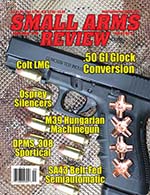By James L. Ballou
Sometimes it pays to take a second look through one’s source material. Doing this resulted in the following discoveries. An invoice dated January 17, 1938 revealed the following information. The Wisconsin National Guard recorded the shipment of 18 M1922 Cavalry Model Browning Automatic Rifles to the Rock Island Arsenal for Modification to the new 1918 A2 improved model. The serial numbers prove that the M1922 were not separately serial numbered, but rather randomly selected from all three World War I manufacturers as there are Colt, ,Winchester, and Marlin serial numbers. What makes this a treasure, you might ask? Suppose you happen to have one of these guns in 1918 A2 configuration? What a treasure!
It is the opinion of this author that there is no such thing as a “mint gun.” Only coins can be mint. A piece comes off the production line, it becomes like a living entity, it begins to age and have a life of its own. It gets test fired and begins to get scratched. It might get placed in a museum but the elements take their toll. Or, it may go into combat and it has scars of war. The M1918 rifle may be upgraded to a M1922 Cavalry Model, then again modified to M1918 A1 and, eventually to M1918 A2 and parkerized. This is the metamorphosis of the Weapon and who are we to change its appearance cosmetically or to improve or retrofit its original appearance? After all, we are only custodians of the weapon to preserve it for the next generation. In some ways it owns us. It will always be a refinished gun.
Suppose you find one of the BARs on this list that was originally a M1922 Cavalry Model, it would be great to have it in this rare incarnation. In this article you will find photographs and drawings that might help you in your quest.
What else was found in this cache of documents? On page 60 of Rock in a Hard Place there is found a photograph of First Lieutenant Kenneth F. King acting as an A-gunner to Lt. Val Browning somewhere in France, October, 1918. A document titled Transfer of Ordnance Property, dated March 9, 1918 from Major D.W. Moore, Inspector of Ordnance, Winchester Repeating Arms Co. was executed to send four Browning Machine Rifles to Kenneth T. King, 1st Lt. OD N.A .at Washington, D.C. Can we prove that this might be the serial number of the gun in the photo? No, but we now know that each gun was shipped with 20 magazines and also a list of spares: magazine filler, 1 for every 2 rifles; connectors, 1 for every rifle; extractor springs, 1 for every rifle; firing pins, 2 for every rifle; magazine catch spring, 1 for every rifle; recoil spring, 1 for every rifle; sear springs, 1 for every rifle; and finally, slings, 1 for every rifle. Winchester BAR numbers 64978, 64845, 64897 and 64722 were delivered to Lt. K.T. King on March 9, 1918. One of these BARs may be seen being fired by Lt. Val Browning.
From the very beginning of the BAR’s use in the field, attempts were made to increase the magazine capacity of the BAR. Colt immediately designed a 40-round magazine. It was offered early on as an accessory. One of the first BARs tested by the Royal Canadian Mounted Police was supplied with a 40-round magazine in addition to the 20-round regular and referenced as early as August, 1917. In the Photographic Collection of the Imperial War museum there is a photograph dated 1917; so early on, they had the 40-roundd magazine in stock, and in France. They proved to be impractical, heavy and cumbersome in the prone position. What happened to them?
On February 27, 1920, The Infantry and Cavalry Board called for a Modified BAR that could take the place of the M1919 for Cavalry use. This led to the short lived M1922 Cavalry model with a heavy barrel and a bipod they suggested would fill the need for a light Browning. Later a monopod was added. They also tested special carriers and mounts for both horse and mule carry. Most interesting and little known, they asked that 40 thirty-round magazines be produced. They also requested that special canvas carriers be supplied: 20 to go to Camp Benning, and 20 to Ft. Riley, Kansas. This is the last mention of them. Where are these treasures now?
With the price of NFA firearms increasing every day, you may possibly find it more exciting and rewarding to collect the rare accessories and accoutrements. Who knows what treasures reside in attics, warehouses, and closets? Do your research, study the materials and get out there and look. They are out there somewhere, just hiding and unrecognized until you find them. Good Luck.
This article first appeared in Small Arms Review V13N12 (September 2010) |
| SUBSCRIBER COMMENT AREA |
Comments have not been generated for this article.











